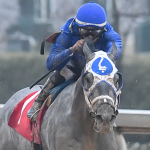
Preakness Quick Sheet: Get to Know the 2021 Preakness Horses

There is one constant that I have seen year after year as it pertains to the Del Mar and Saratoga Race Course summer meetings. Horsemen like to showcase their best 2-year-olds and begin their horse’s career on a winning note.
Invariably these hot 2-year-olds will be bet way down in odds. However, not all of them win at short prices.
What you want to do should they get upset is bet them the second time out if they offer better value. Year after year, this has been a profitable betting angle for me. They call these types of horses “steam” horses.
If there is enough time left in the meet, that second start will happen at Del Mar and Saratoga. But if there isn’t enough time on the calendar that the second start will be when the racing shifts back to Santa Anita Park and Belmont Park.
These well-meant 2-year-olds are easy to spot. When you look at their sales price it is usually north of $250,000. When you study their workout patterns you will see a bullet or bullets that signify the fastest workout at that distance that morning.
If there is backside chatter that eventually reaches the front side, the source is typically the barn itself and/or the clockers who time the morning workouts.
When a barn has a fast 2-year-old, it is nearly impossible to keep under wraps. Even if the source is not the trainer or his employees, it can be other horsemen who just witnessed the next “fastest horse in the world.”
Everybody wants to cash a ticket on a hot horse.
The clockers themselves are a reliable source of information. In the old days, clockers were known to muddy the workouts of a fast animal so as to cash a fat ticket personally and for their clients. That’s not so much the case anymore and here’s why.
If you have multiple clockers all timing a fast work, they are not going to collude to bury the horse’s good form. They get paid for information and if they don’t provide that honest information to their clients they will hurt their own business. It’s just not worth it to them.
So a 2-year-old first-time starter is bet down to even money or less. What do you do?
You can sit on your bankroll and watch knowing a $4 winner is not going to change your life. You could single the horse in vertical and/or horizontal wagers hoping he or she runs as advertised. That’s all up to you.
My focus here is the steam horses that lose. For whatever reason, there are a million ways to lose a race, so I won’t get into that.
The way to keep track of these horses is to enter then immediately into your “horses to watch” list. Don’t trust your memory. Keep records of the ones that catch your eye.
In the second start, that horse may be somewhat forgotten by the betting public or perhaps they soured on the 2-year-old much too soon. Some of your best scores occur when you are a forgiving handicapper.
Find that 2-year-old that debuted at even money and look for value at 7-2, 5-1, or even higher odds for their second start. Now is the time to take the rubber band off your bankroll. You won’t win them all. But the higher win prices represent an overlay on a horse that has shown people smarter than us that it has a lot of ability.
Richard Eng is the author of “Betting on Horse Racing for Dummies”, an introductory book for newcomers to the sport of horse racing. For two decades, he was the turf editor and handicapper for the Las Vegas Review-Journal. He still handicaps the Southern California tracks and his picks are for sale at www.racedaylasvegas.com. You can email him at rich_eng@hotmail.com and follow him on Twitter @richeng4propick and on Facebook.com.